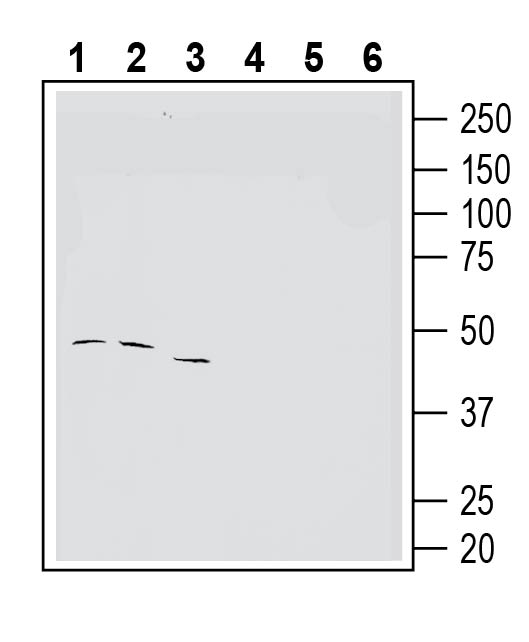Overview
- Peptide (C)DWENTDWFKETKNQS, corresponding to amino acid residues 155 - 169 of human Tetraspanin-3 (Accession O60637). Extracellular, 2nd loop.
 Western blot analysis of rat brain lysates (lanes 1 and 3) and mouse brain lysates (lanes 2 and 4):1-2. Anti-Tetraspanin-3 (extracellular) Antibody (#ANR-185), (1:400).
Western blot analysis of rat brain lysates (lanes 1 and 3) and mouse brain lysates (lanes 2 and 4):1-2. Anti-Tetraspanin-3 (extracellular) Antibody (#ANR-185), (1:400).
3-4. Anti- Tetraspanin-3 (extracellular) Antibody, preincubated with Tetraspanin-3 (extracellular) Blocking Peptide (BLP-NR185). Western blot analysis of human K562 erythroleukemia cell line lysate (lanes 1 and 4), human Jurkat T-cell leukemia cell line lysate (lanes 2 and 5) and human LNCaP prostate adenocarcinoma cell line lysate (lanes 3 and 6):1-3. Anti-Tetraspanin-3 (extracellular) Antibody (#ANR-185), (1:200).
Western blot analysis of human K562 erythroleukemia cell line lysate (lanes 1 and 4), human Jurkat T-cell leukemia cell line lysate (lanes 2 and 5) and human LNCaP prostate adenocarcinoma cell line lysate (lanes 3 and 6):1-3. Anti-Tetraspanin-3 (extracellular) Antibody (#ANR-185), (1:200).
4-6. Anti- Tetraspanin-3 (extracellular) Antibody, preincubated with Tetraspanin-3 (extracellular) Blocking Peptide (BLP-NR185).
Tetraspanin-3, encoded by TSPAN3 gene is a membrane-spanning glycoprotein that has a role in cell migration, proliferation, and interactions between cells and extracellular matrix.
As suggested by the family name, TSPANs are categorized by the presence of four trans-membrane domains, of which two are extracellular. The intracellular part includes the C and N terminal domains that can facilitate protein–protein interactions, as well as guide intracellular trafficking. TSPANs have multiple roles In the immune and vascular systems, and they act as organizers of functional microdomains and multi-subunit receptor complexes 1.
Tspan3 is highly expressed in the brain and elevated in brains of Alzheimer´s disease (AD) patients. It was shown to interact with ADAM10, which is a marker for Alzheimer's disease 2. It was also shown to be expressed by dendritic cells (DCs) which suggests that it may be involved in the function of DCs in association with T cell stimulation 3.
Its functional diversity and importance for the development and onset of various diseases makes Tetraspanin 3 an appealing research target.
